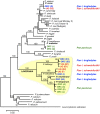On the diversity of malaria parasites in African apes and the origin of Plasmodium falciparum from Bonobos
- PMID: 20169187
- PMCID: PMC2820532
- DOI: 10.1371/journal.ppat.1000765
On the diversity of malaria parasites in African apes and the origin of Plasmodium falciparum from Bonobos
Abstract
The origin of Plasmodium falciparum, the etiological agent of the most dangerous forms of human malaria, remains controversial. Although investigations of homologous parasites in African Apes are crucial to resolve this issue, studies have been restricted to a chimpanzee parasite related to P. falciparum, P. reichenowi, for which a single isolate was available until very recently. Using PCR amplification, we detected Plasmodium parasites in blood samples from 18 of 91 individuals of the genus Pan, including six chimpanzees (three Pan troglodytes troglodytes, three Pan t. schweinfurthii) and twelve bonobos (Pan paniscus). We obtained sequences of the parasites' mitochondrial genomes and/or from two nuclear genes from 14 samples. In addition to P. reichenowi, three other hitherto unknown lineages were found in the chimpanzees. One is related to P. vivax and two to P. falciparum that are likely to belong to distinct species. In the bonobos we found P. falciparum parasites whose mitochondrial genomes indicated that they were distinct from those present in humans, and another parasite lineage related to P. malariae. Phylogenetic analyses based on this diverse set of Plasmodium parasites in African Apes shed new light on the evolutionary history of P. falciparum. The data suggested that P. falciparum did not originate from P. reichenowi of chimpanzees (Pan troglodytes), but rather evolved in bonobos (Pan paniscus), from which it subsequently colonized humans by a host-switch. Finally, our data and that of others indicated that chimpanzees and bonobos maintain malaria parasites, to which humans are susceptible, a factor of some relevance to the renewed efforts to eradicate malaria.
Conflict of interest statement
The authors have declared that no competing interests exist.
Figures




Similar articles
-
Origin of the human malaria parasite Plasmodium falciparum in gorillas.Nature. 2010 Sep 23;467(7314):420-5. doi: 10.1038/nature09442. Nature. 2010. PMID: 20864995 Free PMC article.
-
Multigenomic Delineation of Plasmodium Species of the Laverania Subgenus Infecting Wild-Living Chimpanzees and Gorillas.Genome Biol Evol. 2016 Jul 2;8(6):1929-39. doi: 10.1093/gbe/evw128. Genome Biol Evol. 2016. PMID: 27289102 Free PMC article.
-
African apes as reservoirs of Plasmodium falciparum and the origin and diversification of the Laverania subgenus.Proc Natl Acad Sci U S A. 2010 Jun 8;107(23):10561-6. doi: 10.1073/pnas.1005435107. Epub 2010 May 24. Proc Natl Acad Sci U S A. 2010. PMID: 20498054 Free PMC article.
-
Ape Origins of Human Malaria.Annu Rev Microbiol. 2020 Sep 8;74:39-63. doi: 10.1146/annurev-micro-020518-115628. Annu Rev Microbiol. 2020. PMID: 32905751 Free PMC article. Review.
-
[From malaria parasite point of view--Plasmodium falciparum evolution].Postepy Hig Med Dosw (Online). 2015 Dec 31;69:1519-29. Postepy Hig Med Dosw (Online). 2015. PMID: 27259224 Review. Polish.
Cited by
-
Investigations on anopheline mosquitoes close to the nest sites of chimpanzees subject to malaria infection in Ugandan highlands.Malar J. 2012 Apr 17;11:116. doi: 10.1186/1475-2875-11-116. Malar J. 2012. PMID: 22510395 Free PMC article.
-
The fragmented mitochondrial ribosomal RNAs of Plasmodium falciparum.PLoS One. 2012;7(6):e38320. doi: 10.1371/journal.pone.0038320. Epub 2012 Jun 22. PLoS One. 2012. PMID: 22761677 Free PMC article.
-
Men, primates, and germs: an ongoing affair.Curr Top Microbiol Immunol. 2013;365:337-53. doi: 10.1007/82_2012_304. Curr Top Microbiol Immunol. 2013. PMID: 23239237 Free PMC article. Review.
-
Prevalence of Malaria and Associated Risk Factors among the Community of Mizan-Aman Town and Its Catchment Area in Southwest Ethiopia.J Parasitol Res. 2022 Apr 12;2022:3503317. doi: 10.1155/2022/3503317. eCollection 2022. J Parasitol Res. 2022. PMID: 35464173 Free PMC article.
-
A plethora of Plasmodium species in wild apes: a source of human infection?Trends Parasitol. 2011 May;27(5):222-9. doi: 10.1016/j.pt.2011.01.006. Epub 2011 Feb 25. Trends Parasitol. 2011. PMID: 21354860 Free PMC article. Review.
References
-
- Qari SH, Shi Y-P, Pieniazek NJ, Collins WE, Lal AA. Phylogenetic relationship among the malaria parasites based on small subunit rRNA gene sequences: monophyletic nature of the human malaria parasite, Plasmodium falciparum. Mol Phylogenet Evol. 1996;6:157–165. - PubMed
-
- Escalante AA, Barrio E, Ayala FJ. Evolutionary origin of human and primate malarias: evidence from the circumsporozoite protein gene. Mol Biol Evol. 1995;12:616–626. - PubMed
Publication types
MeSH terms
Grants and funding
LinkOut - more resources
Full Text Sources
Other Literature Sources

